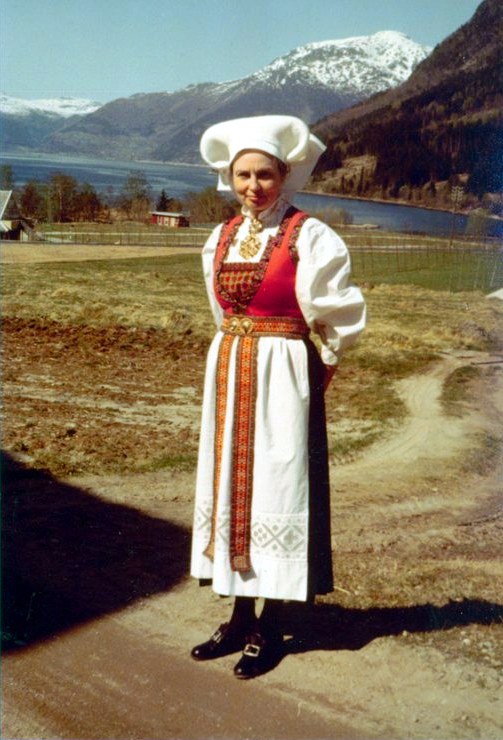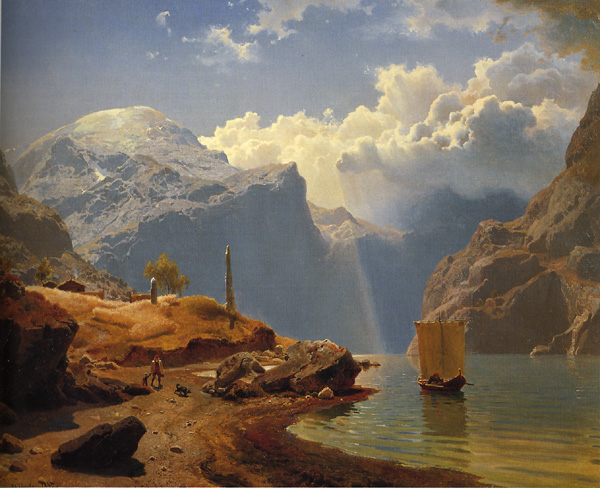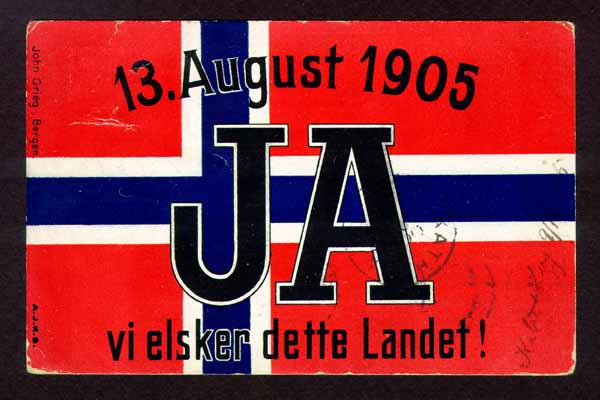|
Hardangerbunad
Hardangerbunad is a collective term for bunads from the villages in the traditional district of Hardanger, Norway, with various local varieties. The bunad includes the areas Kvam, Granvin, Ulvik, Eidfjord, Jondal, Ullensvang and Odda. Hardanger is one of the areas in Norway that has had a strong folk costume tradition, and with the national romantic in the late 1800s, the church clothes from this area were lifted to be a Norwegian national symbol, and the Hardangerbunad therefore has the nickname "Nasjonalen", in English "The National". The Hardangerbunad was used by women from all over the Norway to show support for dissolution of the union between Norway and Sweden in 1905.''Hol Haugen, Bjørn Sverre'' (2006). Norsk bunadleksikon. N.W. Damm & Søn. Female bunads The bunads for women have black skirt, and are found in party variants with red or green bodice and white apron, or black bodice and black apron. Over large parts of the bunad, including the belt and apron, there a ... [...More Info...] [...Related Items...] OR: [Wikipedia] [Google] [Baidu] |
Bunad
''Bunad'' (, plural: ''bunader''/''bunadar'') is a Norwegian umbrella term encompassing, in its broadest sense, a range of both traditional rural clothes (mostly dating to the 18th and 19th centuries) as well as modern 20th-century folk costumes. In its narrow sense the word ''bunad'' refers only to clothes designed in the early 20th century that are loosely based on traditional costumes. The word ''bunad'' in itself is a 20th-century invention. The bunad movement has its root in 19th-century national romanticism, which included an interest for traditional folk costumes not only in Norway, but also in neighbouring countries such as Denmark and notably Germany. However, in Norway, national romanticist ideas had a more lasting impact, as seen in the use of folk-inspired costumes. History The bunad movement has been carried forward by enthusiasts all over the country and new bunad variations are frequently created and proposed for approval. Designers such as Lise Skjåk Bræk h ... [...More Info...] [...Related Items...] OR: [Wikipedia] [Google] [Baidu] |
Hardanger
Hardanger is a traditional district in the western part of Norway, dominated by the Hardangerfjord and its inner branches of the Sørfjorden and the Eid Fjord. It consists of the municipalities of Ullensvang, Eidfjord, Ulvik and Kvam, and is located inside the county of Vestland. The area is dominated by the vast Hardangervidda plateau in the east and the large Folgefonna glacier on the central Folgefonna peninsula. The district was selected as the millennium site for the old Hordaland county. In the early Viking Age, before Harald Fairhair, Hardanger was a petty kingdom with its capital at Kinsarvik. Etymology The Old Norse form of the name was ''Harðangr''. The first element is derived from the ethnonym '' hǫrðar'', or from ''harðr'' meaning "hard" (referring to wind and weather). The last element is ''angr'' "tight fjord" (the name originally belonged to the fjord, now called Hardangerfjord). Agriculture The region is one of Norway's most important sources of fruit ... [...More Info...] [...Related Items...] OR: [Wikipedia] [Google] [Baidu] |
Folk Costume
A folk costume (also regional costume, national costume, traditional garment, or traditional regalia) expresses an identity through costume, which is usually associated with a geographic area or a period of time in history. It can also indicate social, marital or religious status. If the costume is used to represent the culture or identity of a specific ethnic group, it is usually known as ethnic costume (also ethnic dress, ethnic wear, ethnic clothing, traditional ethnic wear or traditional ethnic garment). Such costumes often come in two forms: one for everyday occasions, the other for traditional festivals and formal wear. Following the rise of romantic nationalism, the pre-industrial peasantry of Europe came to serve as models for all that appeared genuine and desirable. Their dresses are crystallized into so-called "typical" forms, and enthusiasts adopted that attire as part of their symbolism. In areas where Western dress codes have become usual, traditional garments ar ... [...More Info...] [...Related Items...] OR: [Wikipedia] [Google] [Baidu] |
Kinsarvik
Kinsarvik is a village in the municipality of Ullensvang in Vestland county, Norway. The village is located at the end of a small bay at the confluence of the Sørfjorden and the Eid Fjord, where they join to form the main branch of the Hardangerfjorden. The village lies along the Norwegian National Road 13 and it has a ferry port with regular routes that connect it to Utne and Kvanndal across the fjord. The village has a population (2019) of 555 and a population density of . Due to its important location along the Hardangerfjorden, Kinsarvik has been an important location since the Viking Age. Kinsarvik has been the site of Kinsarvik Church since the 12th century, serving the people of the whole region. The parish of Kinsarvik was made into a municipality in 1838. Kinsarvik Municipality existed as a municipality off and on from 1838 until 1964 when it was merged into Ullensvang. This village was the administrative centre of Ullensvang until 2020 when the municipality was ... [...More Info...] [...Related Items...] OR: [Wikipedia] [Google] [Baidu] |
Bridal Crown
Traditionally a bridal crown (german: Brautkrone or, in the Black Forest, ''Schäppel'') is a headdress that, in Central and Northern Europe, single women wear on certain holidays, at festivals and, finally, at their wedding. Bridal crowns today, of another type, are also often provided by church parishes for the use of brides at their weddings. History A bridal crown, along with the bridal wreath and veil, is probably the oldest decorative form of headdress worn by women. With it the bride would symbolise her purity and it was also a status symbol for her family. Especially in farming areas, the bridal crown was and is very popular. In several regions the bride takes her crown off after the church service and hangs it over the wedding table as a sign of the peace. The design of bridal crowns is very varied and depends on the place and region. To begin with they were decorated with flowers, fir branches, herbs and ripe fruits. In later times and even today, more expensive mat ... [...More Info...] [...Related Items...] OR: [Wikipedia] [Google] [Baidu] |
Apron
An apron is a garment that is worn over other clothing to cover the front of the body. The word comes from old French ''napron'' meaning a small piece of cloth, however over time "a napron" became "an apron", through a linguistics process called rebracketing. It may have several purposes, typically as a functional accessory that protects clothes and skin from stains and marks. However, other types of aprons may be worn as a decoration, for hygienic reasons, as part of a uniform, or as protection from certain dangers such as acid, allergens or excessive heat. It can also be used at work stations to hold extra tools and pieces or protect from dust and unwanted materials. As a top layer that covers the front body, the apron is also worn as a uniform, adornment, ceremonial garb (e.g. Masonic apron) or fashion statement. Apron styles can be practical, fashionable, and sentimental. Apron styles There are many different apron forms depending on the purpose of the apron. A basic di ... [...More Info...] [...Related Items...] OR: [Wikipedia] [Google] [Baidu] |
Bodice
A bodice () is an article of clothing traditionally for women and girls, covering the torso from the neck to the waist. The term typically refers to a specific type of upper garment common in Europe during the 16th to the 18th century, or to the upper portion of a modern dress to distinguish it from the skirt and sleeves. The name ''bodice'' is etymologically an odd plural spelling of "body" and comes from an older garment called a ''pair of bodies'' (because the garment was originally made in two separate pieces that fastened together, frequently by lacing). Origin Frescoes produced by the Minoan civilization portray women wearing open bodices that displayed and accentuated their breasts; however, following the Late Bronze Age collapse, these garments would give way to the simpler clothes characteristic of Iron Age Greece. Contemporary European bodices are derived from the kirtle. A fitted bodice became fashionable in Europe around 1450. Classification The same word is ... [...More Info...] [...Related Items...] OR: [Wikipedia] [Google] [Baidu] |
Dissolution Of The Union Between Norway And Sweden
The dissolution of the union ( nb, unionsoppløsningen; nn, unionsoppløysinga; Landsmål: ''unionsuppløysingi''; sv, unionsupplösningen) between the kingdoms of Norway and Sweden under the House of Bernadotte, was set in motion by a resolution of the Storting on 7 June 1905. Following some months of tension and fear of an outbreak of war between the neighbouring kingdoms (then in personal union) – and a Norwegian plebiscite held on 13 August which overwhelmingly backed dissolution – negotiations between the two governments led to Sweden's recognition of Norway as an independent constitutional monarchy on 26 October 1905. On that date, King Oscar II renounced his claim to the Norwegian throne, effectively dissolving the United Kingdoms of Sweden and Norway, and this event was swiftly followed, on 18 November, by the accession to the Norwegian throne of Prince Carl of Denmark, taking the name of Haakon VII. Background Norwegian nationalistic aspirations in 1814 were f ... [...More Info...] [...Related Items...] OR: [Wikipedia] [Google] [Baidu] |
Dagbladet
''Dagbladet'' (lit.: ''The Daily Magazine'') is one of Norway's largest newspapers and is published in the tabloid format. It has 1,400,000 daily readers on mobile, web and paper. Traditionally ''Dagbladet'' is considered the main liberal newspaper of Norway, with a generally liberal progressive editorial outlook, to some extent associated with the movement of cultural radicalism in Scandinavian history. The paper edition had a circulation of 46,250 copies in 2016, down from a peak of 228,834 in 1994. The editor-in-chief is Alexandra Beverfjord, the political editor is Geir Ramnefjell, the news editor is Frode Hansen and the culture editor is Sigrid Hvidsten. ''Dagbladet'' is published six days a week and includes the additional feature magazine ''Magasinet'' every Saturday. Part of the daily tabloid is available at ''Dagbladet.no'', and more articles can be accessed through a paywall. The daily readership of ''Dagbladet''s online tabloid was 1.24 million in 2016. History '' ... [...More Info...] [...Related Items...] OR: [Wikipedia] [Google] [Baidu] |
National Romantic
Romantic nationalism (also national romanticism, organic nationalism, identity nationalism) is the form of nationalism in which the state claims its political legitimacy as an organic consequence of the unity of those it governs. This includes such factors as language, race, ethnicity, culture, religion, and customs of the nation in its primal sense of those who were born within its culture. It can be applied to ethnic nationalism as well as civic nationalism. Romantic nationalism arose in reaction to dynastic or imperial hegemony, which assessed the legitimacy of the state from the top down, emanating from a monarch or other authority, which justified its existence. Such downward-radiating power might ultimately derive from a god or gods (see the divine right of kings and the Mandate of Heaven). Among the key themes of Romanticism, and its most enduring legacy, the cultural assertions of romantic nationalism have also been central in post-Enlightenment art and political phi ... [...More Info...] [...Related Items...] OR: [Wikipedia] [Google] [Baidu] |
Ullensvang
Ullensvang is a municipality in Vestland county, Norway. It is located in the traditional district of Hardanger. The administrative centre is the town of Odda. Some of the notable villages in the municipality include Lofthus, Utne, Vikebygd, Alsåker, Botnen, Eitrheim, Håra, Røldal, Seljestad, Skare, Tyssedal, Jondal, Herand, Kysnesstranda, and Torsnes. The main inhabited part of Ullensvang municipality lies just to the west of Hardangervidda National Park, which covers most of the Hardangervidda plateau, Europe's largest mountain plateau. Most inhabitants live in the narrow coastal mountainsides and valleys along the Hardangerfjorden and Sørfjorden. The largest urban areas in Ullensvang are Odda, Kinsarvik, Jondal, and Lofthus. The Norwegian National Road 13 and the European route E134 are the two main roads through the municipality. National road 13 crosses the Hardangerfjorden via the Hardanger Bridge in the far northern part of the municipality. The ... [...More Info...] [...Related Items...] OR: [Wikipedia] [Google] [Baidu] |






.jpg)
.jpg)


